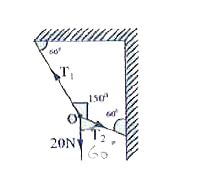(A): A body is momentarily at rest at the instant it reverses the direction.
(R): A body cannot have acceleration if its velocity is zero at a given instant of time. Solution in Telugu
Both (A) and (R) are true and (R) is the correct explanation of (A)
Both (A) and (R) are true and (R) is not the correct explanation of (A)
(A) is true but (R) is false
Both (A) and (R) are fals
The correct Answer is:C
Step by step video, text & image solution for (A): A body is momentarily at rest at the instant it reverses the direction. (R): A body cannot have acceleration if its velocity is zero at a given instant of time. by Physics experts to help you in doubts & scoring excellent marks in Class 12 exams.
Topper's Solved these Questions
- BOOK - AAKASH SERIESCHAPTER - MOTION IN A PLANEEXERCISE - EXERCISE-2 (Addition, Subtraction and Resolution)29videos
MOTION IN A PLANE
- BOOK - AAKASH SERIESCHAPTER - MOTION IN A PLANEEXERCISE - EXERCISE-2 (Lami.s theorem :)8videos
MOTION IN A PLANE
- BOOK - AAKASH SERIESCHAPTER - MOTION IN A PLANEEXERCISE - EXERCISE-IB (Projectile motion)15videos
MOTION IN A PLANE
- BOOK - AAKASH SERIESCHAPTER - MAGNETISMEXERCISE - PROBLEMS (LEVEL-II)13videos
MAGNETISM
- BOOK - AAKASH SERIESCHAPTER - MOTION IN A PLANEEXERCISE - QUESTION FOR DESCRIPTIVE ANSWER7videos
MOTION IN A PLANE
Similar Questions
A person runs along a circular path of radius 5 m. If he completes half of the circle find the magnitude of the displacement vector, How far the person ran ?
01:55View SolutionIf 'O' is at equilibrium then the values of the tension T1andT2 are x, y, if 20 N is vertically down. Then x, y are
 01:30View Solution
01:30View Solution(A): The horizontal displacement of a projectile varies linearly with time.
(R) : Projectile motion is uniform motion along horizontal direction.02:13View SolutionThe force between the two poles is reduced to 'x' newtons when their separation is increased n times. It is increased by 'y' newtons when their separation is made 1/nth of their original value. What is the relation between x and y?
02:14View SolutionA particle is projected over a triangle from one end of a horizontal base and garzing the vertex falls on the other end of the base . If α and β the base angles and θ the angle of projection then show that tanθ=tanα+tanβ.
View SolutionStatement I: A body can have acceleration even if its velcity is zero at a given instant .
Statement II: A body is momentarily at rest when it reverses its direction of velocity.02:14View SolutionAssertion : A body can have acceleration even if its velocity is zero at a given instant of time.
Reason : A body is momentarily at rest when it reverses its direction of motion.View SolutionAssertion : A body is momentarily at rest at the instant it reverses the direction. Reason : A body cannot have acceleration if its velocity is zero at a given instant of time.
02:14View Solution(A) : A body can have acceleration even if its velocity is zero at a given instant of time.
(r) : A body is momentarily at rest when it reverses its direction of motion.View Solution(A): A body can have acceleration even if its velocity is zero at a given instant of time. (R): A body is momentarily at rest when it reverses its direction of motion.
View Solution(A) : A body can have acceleration even if its velocity is zero at a given instant of time. (r) : A body is momentarily at rest when it reverses its direction of motion.
01:39View Solution(A):A body can have acceleration even if its velocity is zero at a given instant of time. (R ):A body can is momentarily at rest when it reverses its direction of motion .
01:18View Solution(A) : A body can have acceleration even if its velocity is zero at a given instant of time.
(r) : A body is momentarily at rest when it reverses its direction of motion.View Solution(A) : A body can have acceleration even if its velocity is zero at a given instant of time. (R ) : A body is momentarily at rest when it reverses its direction of motion
View Solution(A) : A body can have acceleration even if its velocity is zero at a given instant of time.
(R ) : A body is momentarily at rest when it reverses its direction of motion02:11View Solution

